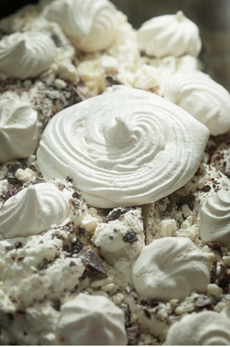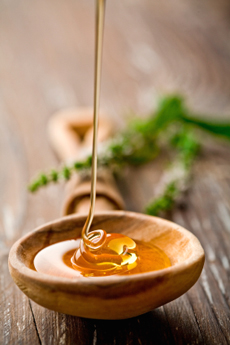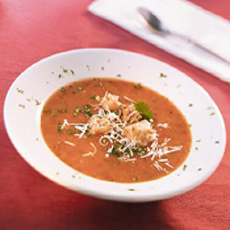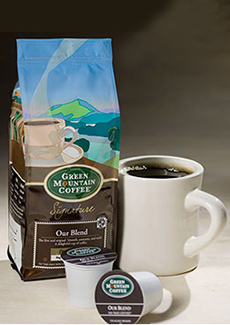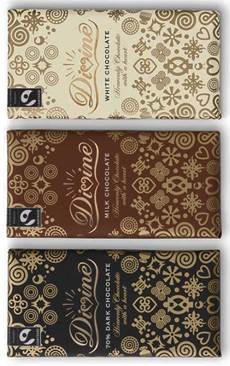|
Preparation
1. PREHEAT oven to 225°.
2. BEAT egg whites in large bowl with electric mixer on low-medium speed, until frothy. If using a freestanding mixer, use wire whisk attachment.
3. ADD cream of tartar; continue to beat until soft peaks form. Increase speed to medium-high. Add sugar, 1 tablespoon at a time, beating until sugar is dissolved and stiff peaks form. Beat in optional extract and food color until well blended. Gently stir in optional chips or nuts. TIP: The meringue is finished if you rub a bit between your fingers and it feels smooth. If it feels gritty, then the sugar has not fully dissolved; keep beating.
4. FIT a pastry bag with a 1/2 inch (1.25 cm) plain tip to make swirled meringues. Otherwise, drop by rounded teaspoonfuls about 1 inch apart onto 2 large foil-lined baking sheets sprayed with non-stick cooking spray.
|
|
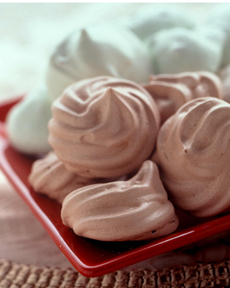
Swirled meringue cookies are piped from a pastry bag. Photo courtesy American Egg Board.
|
5. BAKE both sheets at the same time, for 45 minutes. Let the meringues stand in the oven with the door ajar for 1 hour, or until completely cooled. (You can let them sit overnight in the cold oven.) The cookies will keep, stored in an airtight container, for 3 days or more.
MERINGUE HISTORY
The exact inventor of meringue is not known. Some culinary historians believe that meringue was invented by an Italian pastry chef named Gasparini in the town of Meiringen, Switzerland.
Others say that the term comes from the Polish word marzynka, and that it was invented by a chef in the service of Stanislas Leszczynski (1677-1736). The king was deposed in 1709 and later became the Duke of Lorraine, in France. In this story of provenance, Stanislas’s daughter Marie, who married French King Louis XV, popularized meringues in France. Her daughter-in-law, Marie Antoinette, was a great fan of meringues and is said to have made them herself at the Petit Trianon, a small château on the grounds of the Palace of Versailles where, out of the public eye, she was able to live like everyday folk. (Everyday rich folk, that is.)
But meringue may in fact be an English invention. The earliest known recipe for a “baked-beaten-egg-white-and-sugar confection” is 1604, found in a book of recipes begun then by Lady Elinor Fettiplace of Oxfordshire. Here’s more about the origins and types of meringue.
Whoever created the recipe, early meringues were simply dropped with a spoon. It was the great French chef Antoine Carême (1784-1833), who piped the mixture into fancy shapes with a pastry bag.
LOVE MERINGUE?
Check out the delicious book Meringue.
Meringue can be hard (cookies) or soft (toppings). It can be baked, poached or whipped. It can be combined with ground nuts, chocolate or any number of flavorings. It can be piped into various vessels for chantilly (whipped cream), mousse and/or fresh berries. It can create:
Cakes, pies, tarts, tortes
Cookies, bars, pavlovas
Dacquoises, vacherins
Frosting and other luscious creations
Time to start cooking!
|
